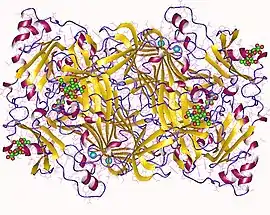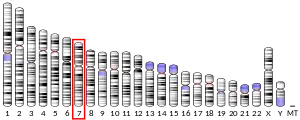Diamine oxidase
Diamine oxidase (DAO), also known "amine oxidase, copper-containing, 1" (AOC1), formerly called histaminase,[5] is an enzyme (EC 1.4.3.22) involved in the metabolism, oxidation, and inactivation of histamine and other polyamines such as putrescine or spermidine. The enzyme belongs to the amine oxidase (copper-containing) (AOC) family of amine oxidase enzymes.
| Diamine oxidase | |||||||||
|---|---|---|---|---|---|---|---|---|---|
 Diamine oxidase dimer, Human | |||||||||
| Identifiers | |||||||||
| EC no. | 1.4.3.22 | ||||||||
| Databases | |||||||||
| IntEnz | IntEnz view | ||||||||
| BRENDA | BRENDA entry | ||||||||
| ExPASy | NiceZyme view | ||||||||
| KEGG | KEGG entry | ||||||||
| MetaCyc | metabolic pathway | ||||||||
| PRIAM | profile | ||||||||
| PDB structures | RCSB PDB PDBe PDBsum | ||||||||
| Gene Ontology | AmiGO / QuickGO | ||||||||
| |||||||||
| AOC1 | |||||||||||||||||||||||||||||||||||||||||||||||||||
|---|---|---|---|---|---|---|---|---|---|---|---|---|---|---|---|---|---|---|---|---|---|---|---|---|---|---|---|---|---|---|---|---|---|---|---|---|---|---|---|---|---|---|---|---|---|---|---|---|---|---|---|
| |||||||||||||||||||||||||||||||||||||||||||||||||||
| Identifiers | |||||||||||||||||||||||||||||||||||||||||||||||||||
| Aliases | AOC1, ABP, ABP1, DAO, DAO1, KAO, amine oxidase, copper containing 1, amine oxidase copper containing 1 | ||||||||||||||||||||||||||||||||||||||||||||||||||
| External IDs | OMIM: 104610 MGI: 1923757 HomoloGene: 68159 GeneCards: AOC1 | ||||||||||||||||||||||||||||||||||||||||||||||||||
| |||||||||||||||||||||||||||||||||||||||||||||||||||
| |||||||||||||||||||||||||||||||||||||||||||||||||||
| |||||||||||||||||||||||||||||||||||||||||||||||||||
| |||||||||||||||||||||||||||||||||||||||||||||||||||
| Wikidata | |||||||||||||||||||||||||||||||||||||||||||||||||||
| |||||||||||||||||||||||||||||||||||||||||||||||||||
The enzyme is expressed in bilateria, a biological group of animals. The enzyme is encoded by the AOC1 gene. This gene is highly conserved across the bilateria group which includes mammals, birds, reptiles, fish and insects, to name a few.
Chemical activity
DAO catalyzes the oxidative deamination of polyamines, such as histamine and putrescine, to produce aminoaldehydes, hydrogen peroxide, and ammonia.
Biological role
DAO is involved in the physiology of digestion and other physiological processes, such as inflammation, immune response, and wound healing. Dysfunction of DAO has been associated with various diseases, including allergies, autoimmune disorders, and cancer. DAO also plays a role in healthy pregnancy in placental mammals.
In case of a shortage or low enzymatic activity of diamine oxidase in the human body, it may appear as an allergy or histamine intolerance.[6][7]
Expression
In placental mammals, including humans, the highest levels of DAO expression are observed in the digestive tract (intestinal mucosa) and the placenta. DAO expression is also observed in kidney of various species.
DAO is also expressed in eosinophils.[8][9]
The role in human pregnancy
In humans, a certain subtype of cells of the placenta, namely the extravillous trophoblasts, express the enzyme and secrete it into the blood stream of a pregnant woman.[10]
During pregnancy, DAO plays a crucial role in maintaining fetal growth and development by regulating histamine levels.[10] DAO levels in the blood circulation increases vastly in pregnant women suggesting a protective mechanism against adverse histamine.[11] Histamine is a potent vasodilator and can cause uterine contractions, which can lead to premature labor. DAO in the placenta breaks down histamine to prevent its accumulation and maintain a healthy pregnancy. Low levels of DAO in the placenta may contribute to preeclampsia, a pregnancy-related disorder characterized by mother's high blood pressure and damage to mother's organs such as the liver and kidneys; the baby may also be affected if the condition is severe or left untreated, but it is not the primary target of the disorder.
Lowered diamine oxidase values in maternal blood in early pregnancy might be an indication for trophoblast-related pregnancy disorders like early-onset preeclampsia.[11]
References
- GRCh38: Ensembl release 89: ENSG00000002726 - Ensembl, May 2017
- GRCm38: Ensembl release 89: ENSMUSG00000029811 - Ensembl, May 2017
- "Human PubMed Reference:". National Center for Biotechnology Information, U.S. National Library of Medicine.
- "Mouse PubMed Reference:". National Center for Biotechnology Information, U.S. National Library of Medicine.
- Wolvekamp MC, de Bruin RW (1994). "Diamine oxidase: an overview of historical, biochemical and functional aspects". Digestive Diseases. 12 (1): 2–14. doi:10.1159/000171432. PMID 8200121.
- Manzotti G, Breda D, Di Gioacchino M, Burastero SE (March 2016). "Serum diamine oxidase activity in patients with histamine intolerance". International Journal of Immunopathology and Pharmacology. 29 (1): 105–11. doi:10.1177/0394632015617170. PMC 5806734. PMID 26574488.
- Music E, Silar M, Korosec P, Kosnik M, Rijavec M (2011). "Serum diamine oxidase (DAO) activity as a diagnostic test for histamine intolerance". Clinical and Translational Allergy. 1 (Suppl 1): P115. doi:10.1186/2045-7022-1-S1-P115. PMC 3354134.
- Zeiger RS, Colten HR (February 1977). "Histaminase release from human eosinophils". Journal of Immunology. 118 (2): 540–3. doi:10.4049/jimmunol.118.2.540. PMID 402420. S2CID 36128339.
- Agúndez JA, Ayuso P, Cornejo-García JA, Blanca M, Torres MJ, Doña I, et al. (2012). "The diamine oxidase gene is associated with hypersensitivity response to non-steroidal anti-inflammatory drugs". PLOS ONE. 7 (11): e47571. Bibcode:2012PLoSO...747571A. doi:10.1371/journal.pone.0047571. PMC 3495953. PMID 23152756.
- Maintz L, Schwarzer V, Bieber T, van der Ven K, Novak N (2008). "Effects of histamine and diamine oxidase activities on pregnancy: a critical review". Hum Reprod Update. 14 (5): 485–95. doi:10.1093/humupd/dmn014. PMID 18499706.
- Velicky P, Windsperger K, Petroczi K, Pils S, Reiter B, Weiss T, et al. (April 2018). "Pregnancy-associated diamine oxidase originates from extravillous trophoblasts and is decreased in early-onset preeclampsia". Scientific Reports. 8 (1): 6342. Bibcode:2018NatSR...8.6342V. doi:10.1038/s41598-018-24652-0. PMC 5910386. PMID 29679053.
External links
- Amine+Oxidase+(Copper-Containing) at the U.S. National Library of Medicine Medical Subject Headings (MeSH)



